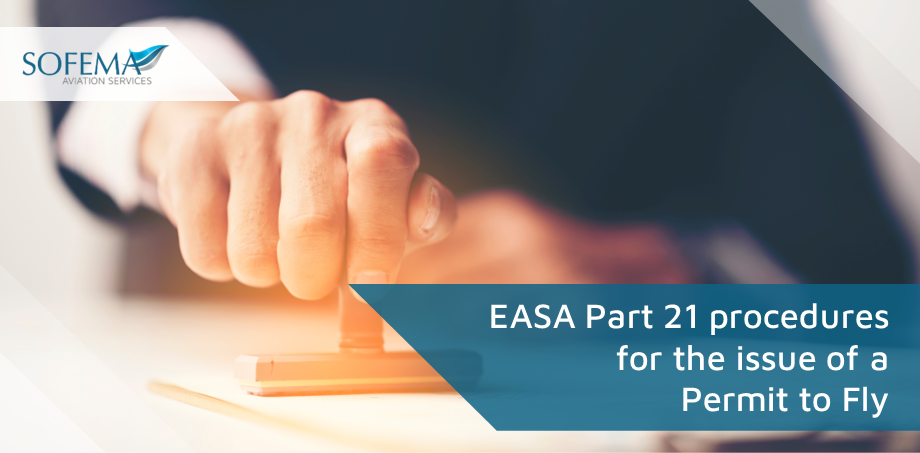Sofema Aviation Services (SAS) considers the key features of the process to obtain a Permit to Fly.
Permit to Fly – Introduction
Commission Regulation (EU) No. 748/2012, Annex I Part 21 makes provision for an EASA Permit to Fly to be issued for an aircraft to fly when a valid EASA airworthiness certificate is currently not in force.
An EASA Permit to Fly may be issued where it can be shown that the aircraft is capable of safe flight under defined conditions and for specific purposes, as outlined in Part 21 Subpart P.
Airworthiness certificates for EASA aircraft are prescribed in Part 21 Subpart H as follows:
a) Certificate of Airworthiness (Form 25)
b) Restricted Certificate of Airworthiness (Form 24)
Permit to Fly (Form 20a) is prescribed in Commission Regulation (EU) No. 748/2012, Annex I Part 21 Subpart P.
- In addition, Subpart P (Part 21A.708) identifies ‘flight conditions’ which must be approved in conjunction with an application for an EASA Permit to Fly.
- Where there is a need to fly an EASA aircraft when an EASA Airworthiness Certificate is not in force or a flight is necessary for the issue of such a certificate, an application will need to be made for an EASA permit to fly, in accordance with the procedures detailed in the subsequent paragraphs of this Notice.
Application
An application for an EASA Permit to Fly is a two-step process requiring:
- Application for approval of flight conditions in accordance with Part 21A.709
- Application for a permit to fly in accordance with Part 21A.707
- Application for approval of flight conditions;
- Applications may be made to;
EASA, or an appropriately approved design organisation, when approval of the flight conditions is related to the safety of the design, or;
Competent Authority or an appropriately approved organisation that will issue the Permit to Fly, when approval of the flight conditions is not related to the safety of design.
Examples of flight conditions not related to the safety of design include, but are not limited to:
- production flight testing for the purpose of conformity establishment;
- delivery/export flight of a new aircraft the design of which is approved;
- demonstrating continuing conformity with the standard previously accepted by EASA for the aircraft or type of aircraft to qualify or re-qualify for a (restricted) certificate of airworthiness.
Introduction AMC 21.A.163(e) Procedure for the issue of a permit to fly including approval of the flight conditions (ED Decision 2012/020/R)
INTENT – This acceptable means of compliance provides means to develop a procedure for the issue of a permit to fly including approval of the flight conditions.
Organisational Procedures Required
- Each POA applicant or holder must develop its own internal procedure following this AMC, in order to obtain the privilege of 21.A.163(e) to issue permits to fly for an aircraft under procedures agreed with its competent authority for production, when the production organisation itself is controlling under its POA the configuration of the aircraft and is attesting conformity with the design conditions approved for the flight.
Procedure for the issue of a “Permit To Fly”
Content – The procedure must address the following points:
- as relevant, in accordance with 21.A.710(b), the approval of flight conditions;
- conformity with approved conditions;
- issue of the permit to fly under the POA privilege;
- authorised signatories;
- interface with the local authority for the flight.
- Approval of the flight conditions (when relevant)
- The procedure must include the process to establish and justify the flight conditions, in accordance with 21.A.708 and how compliance with 21.A.710(c) is established, and include the EASA Form 18B as defined in AMC 21.A.709(b) for the approval under the POA privilege.
- Conformity with approved conditions
o The procedure must indicate how conformity with approved conditions is made, documented and attested by an authorised person.
Issue of the permit to fly under the POA privilege
The procedure must describe the process to prepare the EASA Form 20b and how compliance with 21.A.711(c) and (e) is established before signature of the permit to fly.
Authorised signatories
The person(s) authorised to sign the permit to fly under the privilege of 21.A.163(e) must be identified (name, signature and scope of authority) in the procedure, or in an appropriate document linked to the Production Organisation Exposition.
Interface with the local authority for the flight
The procedure must include provisions describing the communication with the local authority for compliance with the local requirements which are outside the scope of the conditions of 21.A.708(b) (see 21.A.711(e)).
Next Steps
Follow this link to our Library to find & Download related documents for Free.
Note – Sofema Aviation Services offer a training course providing an in-depth understanding of the Part 21 Considerations related to PtF and MCF, as well as how to perform a Risk Assessment:
For additional questions or to register please email team@sassofia.com
Tags:
EASA, Risk Assessment, Airworthiness, Part 21, Commission Regulation (EU) No 748/2012, Airworthiness Certification, Permit to Fly, Part 21 Subpart P, Part 21 Subpart H, MCF, PtF, Maintenance Check Flight




